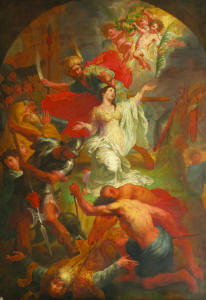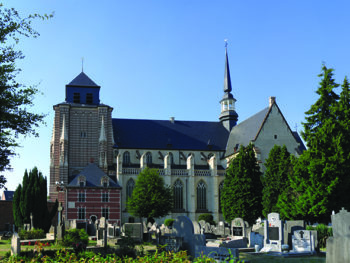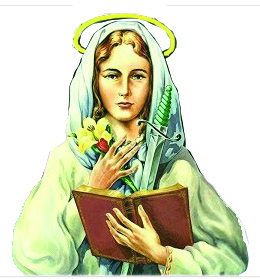St Dymphna

By Tricia O’Donnell
The Belgian city of Geel is renowned for its care for the mentally ill. The modern psychiatric facility that the town now boasts belies the unconventional origins of this care, back in the 13th century. However, we need to go back even further to a young Irish girl who was the catalyst for the reputation Geel holds today.
Dymphna lived in the 7th century. She was the daughter of a devoutly Christian mother and pagan father, Damon, who ruled the small kingdom of Oriel in Ireland. Dymphna was brought up Catholic, was as devout as her mother, and dedicated her life to Christ. Among the household staff was a priest, Father Gerebran, who nurtured the young girl’s faith and taught her daily lessons. When Dymphna was fifteen, her mother died. Her grief-stricken father was inconsolable for a long time. Despite their differences in faith, Damon deeply loved his wife, and it took him over a year before he would consider remarrying.

The Beheading of St Dymphna, Godfried Maes, 1688
However, how could he replace his beautiful wife? Only by finding someone equally attractive, which proved an impossible task for the messengers Damon sent out to search. They travelled all over Ireland and abroad but came back in despair – no one came close to the standard he required.
Whether Damon was advised or decided for himself that his daughter, who looked so much like her mother, was the answer, is not known. Dymphna, of course, was horrified when her father put the proposition to her. He gave her forty days to think about it, and she went immediately to Father Gerebran, who surmised that Damon was on the verge of insanity. He decided, with the help of other household staff, to arrange for Dymphna to leave the country.
After several days of travelling, the little party reached the port and managed to travel to the continent. They landed on the coast not far from Antwerp. From there, they eventually reached Geel, where the locals welcomed them warmly, and decided to settle.
Dymphna’s father was furious when he found out about his daughter’s disappearance and immediately sent his men to find her. They soon discovered that she and her helpers had crossed the sea to Belgium and reported back to Damon, who set out with his entourage to bring her home. When they found Dymphna and Father Gerebran in Geel, Damon demanded she return with him to Ireland, but she refused. When the priest intervened on her behalf, the king ordered his men to kill him, which they duly did.
If he thought Dymphna would have second thoughts and go with him, he was wrong: she stood firm, which enraged him even more. She knew she was no match for him and that he could force her to return with him, and made it very clear that she would never become his wife. Her father’s response was to take out his sword and cut off his daughter’s head. It seems that she was only fifteen years old.
The people of Geel took the bodies of Dymphna and Father Gerebran and buried them in a cave where they remained for several years. Eventually, they were moved to another location, thought to be a small church. Later, a church dedicated to her was built on the site of the original burial place. St Dymphna’s church in Geel holds relics of her although a shrine to the saint in Massilon, Ohio, also has some of her remains. Father Gerebran’s body was moved to Xanten in Germany.

Church of St Dymphna, Geel, Belgium
Soon after Dymphna’s burial place was discovered, there were reports of miracles occurring, particularly among those who were mentally ill and those with epilepsy. Devotion to the saint grew, and in the 13th century The Life of St Dymphna (Vita Sanctae Dimpnae) by the Canon of Cambrai, Petrus Cameracencis, was published, and veneration increased. More and more people settled in Geel, and pilgrims travelled from all over Europe seeking cures for mental illness. A newly-built hospital was unable to cope with the sheer volume of patients, so the townspeople stepped in. Such was their regard for St Dymphna that they took the mentally ill people into their own homes.
That people did this was remarkable in an age when there was little understanding of mental illness and when most people were prey to superstition and fear. The effect of this treatment was startling, as the patients responded positively to living within the day-to-day routines of the families. In many cases, they became part of the family and went on to become part of the broader community. The tradition continues today. The most severe cases stay in the modern psychiatric facility, but when it is possible and appropriate, local people take in ‘boarders’, rather than patients, and help them to adapt to life in the outside world.

De-institutionalisation exists today in the form of half-way houses and other temporary accommodation for psychiatric patients. Geel discovered many years ago that it was the inclusion within family and community life that brought about the best outcomes for those who needed care.
The discovery changed the approach to caring for the mentally ill in that small corner of Belgium. This may never have happened but for the arrival of a young Irish girl whom they took to their hearts all those centuries ago.
St Dymphna is the patron saint of those suffering mental illness, anxiety, abuse and depression. Her feast day is on the 15th of May.
 Entries(RSS)
Entries(RSS)
Thank you for posting this Tricia. I am one of two Dympnas who attended St Catherines's (where we met) in the early 1970s, we remain in regular contact with each other probably united by the name, I have always known the story, but your posting is great for the people who constantly ask me about my name. Regards Dympna Crase (Himatangi Beach).